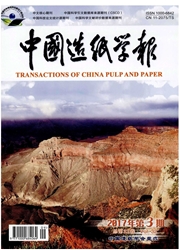

 中文摘要:
中文摘要:
为获得较高的还原糖转化率,用正交实验和单因素实验优化了弱碱性亚硫酸盐预处理蔗渣的工艺条件并将预处理后的蔗渣进行高浓磨浆后再进行酶解处理,采用X射线衍射、红外光谱和扫描电镜对比了蔗渣原料纤维、预处理后和酶解后蔗渣纤维的结晶度和形态的变化。结果表明,在NaOH用量1.5%(化学品用量对蔗渣绝干质量而言)、Na2S03用量10%、液比1:5、蒸煮最高温度160℃、升温时间1h、保温时间1h的预处理条件下,酶解后的蔗渣还原糖转化率较高,为61.1%(对蔗渣原料)。预处理后蔗渣纤维素的结晶度由预处理前的57.1%变为63.3%;酶解后蔗渣纤维素的结晶度由预处理后的63.3%变为55.6%。蔗渣纤维经预处理后和酶解后,各晶面的晶体尺寸增大。红外光谱分析表明,预处理后和酶解后的蔗渣纤维在1037cm^-1处出现了磺酸基的特征峰,说明预处理后蔗渣纤维的部分木素被磺化。预处理后蔗渣纤维表面形成许多微孔,暴露出大量的细小纤维,纤维比表面积增大;酶解后,蔗渣纤维的结构被破坏.有大鼍的残余块状木素。
 英文摘要:
英文摘要:
The condition of weakly alkaline sulfite pretreatment of bagasse was optimized by orthogonal test and single factor test. The optimum condition was as follow: NaOH 1.5%, Na2SO3 10% , the maximum temperature 160℃ and the time of keeping at maximum temperature 1 h. Under this condition, the conversion rate of reducing sugar ( on the bagasse material) reached 61.1% after enzyme hydrolysis. The original and pretreated bagasse, and the sample after enzyme hydrolysis were characterized by XRD, FT-IR and SEM. The results indicated that the crystallinity of cellulose of bagasse increased from 57.1% to 63.3% after the pretreatment, and decreased from 63.3% to 55.6% after enzyme hydrolysis, and the crystallite size also increased after the pretreatment and enzymolysis. The characteristic peak of suffonic group of 1037 cm^-1 indicated part of lignin was sulfonated by the pretreatment. After the pretreatment the surface of cellulose became micro- porous, and many fines were exposed, and the specific surface area of cellulose appeared lager, after enzyme hydrolysis the structure of fiber was destroyed and there were many pieces of lignin remained.
 同期刊论文项目
同期刊论文项目
 同项目期刊论文
同项目期刊论文
 Thermogravimetric-Fourier transform infrared spectrometric analysis of CO2 gasification of reed (Phr
Thermogravimetric-Fourier transform infrared spectrometric analysis of CO2 gasification of reed (Phr Thermogravimetric-Fouriertransform infrared spectrometric analysis of CO2 gasification ofreed (Phrag
Thermogravimetric-Fouriertransform infrared spectrometric analysis of CO2 gasification ofreed (Phrag 期刊信息
期刊信息
